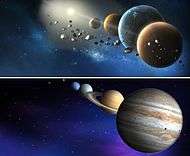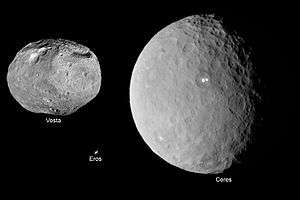Lucy (spacecraft)

Lucy is a proposed mission concept by NASA to tour five Jupiter trojans, which orbit along the planet's path either ahead of or behind Jupiter. Starting in late 2015, the team has one year and 3 million USD to produce more in-depth concept design studies and analyses.[1]
The mission is named after the iconic 'Lucy' hominin skeleton, because studying the trojans could reveal the "fossils of planet formation" or materials that clumped together in the early history of the Solar System to form planets and other bodies.[2]
Overview
Lucy was selected on 30 September 2015 as one of five semifinalists for the Mission #13 of the Discovery Program.[3] Each of the five semifinalist missions received $3 million for a one-year study. The winner will be chosen around December 2016 and must be ready to launch by the end of 2021.[4][5]
Lucy would launch in 2021 and arrive in 2027 to visit three asteroids with a final encounter in 2032. After those flybys, Lucy would return to the vicinity of Jupiter's orbit to visit the last two asteroids, which orbit each other as a binary. Some possible reported targets would be 3548 Eurybates, 21900 Orus, 11351 Leucus, the binary (617) Patroclus-Menoetius, and the belt asteroid 52246 Donaldjohanson, which is named for the discoverer of the Lucy hominin fossil.[6]
Three instruments comprise the proposed payload: a high-resolution visible imager, an optical and near-infrared imaging spectrometer and a thermal infrared spectrometer.[7]
Harold F. Levison of the Southwest Research Institute in Boulder, Colorado is the Principal Investigator with Catherine Olkin of Southwest Research Institute as the mission's Deputy Principal Investigator. NASA's Goddard Space Flight Center would manage the project.
Exploration of Jupiter trojans was one of the goals outlined in the Planetary Science Decadal Survey of this era, and considerable attention has been paid to this goal such as a mission study by Mike Brown (discoverer of Eris) and studies on hardware architecture.[8]
Jupiter trojans have been identified by the Wide-field Infrared Survey Explorer (WISE infrared space telescope) as being "uniformly dark with a hint of burgundy color, and have matte surfaces that reflect little sunlight"[9] Jupiter is 5.2 AU, about five times the Earth-Sun distance from the Sun (1 AU = 149 million kilometers = 93 million miles).[10] The Jupiter trojans are at a similar distance but can be somewhat farther or closer to the Sun depending on where they are in their orbits. There may be as many Jupiter trojans as there are asteroids in the asteroid belt.[11]
Science payload
Possible instrumentation could include:[12]
- color imaging and infrared mapping spectrometer
- high-resolution visible imager
- thermal infrared spectrometer.
- Radio science experiment (uses radio telecommunications hardware)
Targets
Potential targets with their flyby dates may include:[6][13]
- April 2025: 52246 Donaldjohanson, an asteroid in the inner main-belt
- August 2027: 3548 Eurybates, a Jupiter trojan in the Greek camp at L4
- April 2028: 11351 Leucus, a slowly rotating Jupiter trojan in the Greek camp
- October 2028: 21900 Orus rare-type Jupiter trojan in the Greek camp
- March 2032: 617 Patroclus, rare-type binary Jupiter trojan with companion Menoetius in the Trojan camp at L5
See also
- Discovery Program 2015 semifinalists
- Related topics
- 2010 TK7 (an Earth trojan)
- Jupiter Icy Moon Explorer (JUICE, a planned ESA mission to Jupiter system)
References
- ↑ SwRI awarded $3 million NASA contract to develop mission to Jupiter’s Trojan asteroids
- ↑ Witze, Alexandra (16 March 2015). "Five Solar System sights NASA should visit". Nature News. Retrieved 2015-10-02.
- ↑ Brown, Dwayne C.; Cantillo, Laurie (30 September 2015). "NASA Selects Investigations for Future Key Planetary Mission". NASA News. Washington, D.C. Retrieved 2015-10-01.
- ↑ Clark, Stephen (24 February 2014). "NASA receives proposals for new planetary science mission". Space Flight Now. Retrieved 2015-02-25.
- ↑ Kane, Van (December 2, 2014). "Selecting the Next Creative Idea for Exploring the Solar System". Planetary Society. Retrieved 2015-02-10.
- 1 2 Dreier, Casey; Lakdawalla, Emily (30 September 2015). "NASA announces five Discovery proposals selected for further study". The Planetary Society. Retrieved 2015-10-01.
- ↑ "Southwest Research Institute (SwRI) 2015 News Release - SwRI awarded $3 million NASA contract to develop mission to Jupiter's Trojan asteroids". www.swri.org. Retrieved 2015-10-05.
- ↑ TROJAN TOUR ENABLED BY SOLAR ELECTRIC BASED MISSION ARCHITECTURE
- ↑ PIA16211: Trojan Colors Revealed (Artist's Concept)
- ↑
- ↑
- ↑
- ↑ Lucy flyer .pdf



